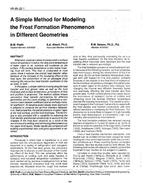Description
Whenever moist air comes in contact with a surface whose temperature is below the dew point temperature of water vapor in air, moisture will condense on the surface. If the surface temperature is also below freezing, frost will form. This frost is undesirable in most cases since it reduces the overall heat transfer either because of the increase in the insulating effect of the frost layer, the constriction of the air passages (thus reducing the convective heat transfer coefficient on the air side), or both.
In this paper, a simple method of computing the heat transfer and frost growth rates as well as the frost thickness and surface temperature as functions of time and position is proposed. The method utilizes known convective heat transfer correlations for different geometries and the Lewis analogy to determine a convective mass transfer coefficient and an enthalpy transfer coefficient. An iterative quasi-steady-state approach is adopted to compute the air-frost interface temperature, frost properties, the partial pressure of water vapor at the frost surface, and the frost thickness. The technique is also provided with a capability for adjusting the frost density and thermal conductivity to account for the changes in the frost layer structure as a result of the occurrence of a melting-and-refreezing phenomenon on the upper frost layers. Model results are compared with existing experimental data and good agreement is obtained.
Citation: Symposium, ASHRAE Trans., vol. 95, pt. 2
Product Details
- Published:
- 1989
- Number of Pages:
- 11
- File Size:
- 1 file , 1.4 MB
- Product Code(s):
- D-28268
